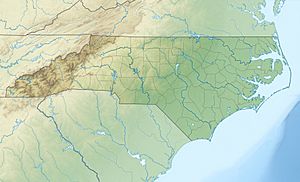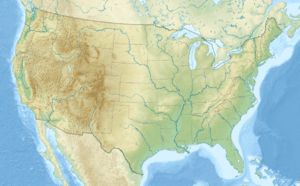Big Branch (Crabtree Creek tributary) facts for kids
Quick facts for kids Big Branch |
|
|---|---|
|
Location of Big Branch mouth
|
|
| Other name(s) | Tributary to Crabtree Creek |
| Country | United States |
| State | North Carolina |
| County | Wake |
| City | Raleigh |
| Physical characteristics | |
| Main source | divide between Big Branch and Mine Creek Raleigh, North Carolina near Falls of the Neuse Road 400 ft (120 m) 35°51′54″N 078°37′44″W / 35.86500°N 78.62889°W |
| River mouth | Crabtree Creek Raleigh, North Carolina 200 ft (61 m) 35°49′05″N 078°37′44″W / 35.81806°N 78.62889°W |
| Length | 3.59 mi (5.78 km) |
| Basin features | |
| Progression | south |
| River system | Neuse River |
| Basin size | 3.98 square miles (10.3 km2) |
| Tributaries |
|
| Bridges | Shanda Drive, Spring Forest Road, Maple Ridge Road, East Millbrook Road, Purdue Street, Compton Road, Hardimont Road, St. Albans Drive, US 1, Cheswick Drive, Six Forks Road |
Big Branch is a small stream, about 3.59 mi (5.78 km) long, located in Wake County, North Carolina. It flows into Crabtree Creek, which is part of the larger Neuse River system. It is considered a "2nd order stream," which means it's formed when two smaller streams (1st order) join together.
Where Does Big Branch Flow?
Big Branch begins in the northern part of Raleigh, North Carolina. It then flows south until it joins Crabtree Creek, right across from a place called Kiwanis Park. Most of the land around Big Branch has been developed with buildings and roads. Only a small part, about 7%, is still covered by forests.
Understanding the Big Branch Watershed
A watershed is an area of land where all the water, like rain or melting snow, drains into a common point, such as a river, lake, or ocean. The Big Branch watershed covers about 3.98 square miles (10.3 km2) of land.
The ground beneath the watershed is made of different types of rock. The upper part has a rock called Falls Leucogneiss, while the middle and lower parts have Raleigh Gneiss. These are types of metamorphic rocks, which means they've been changed by heat and pressure.
The area receives about 46.5 inches of rain each year. The "wetness index" of 415.15 tells scientists how wet the soil and land are in the watershed.



